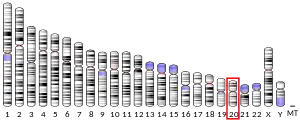| NPBWR2 | |||||||||||||||||||||||||||||||||||||||||||||||||||
|---|---|---|---|---|---|---|---|---|---|---|---|---|---|---|---|---|---|---|---|---|---|---|---|---|---|---|---|---|---|---|---|---|---|---|---|---|---|---|---|---|---|---|---|---|---|---|---|---|---|---|---|
| Identifiers | |||||||||||||||||||||||||||||||||||||||||||||||||||
| Aliases | NPBWR2, GPR8, Neuropeptides B/W receptor 2, neuropeptides B and W receptor 2 | ||||||||||||||||||||||||||||||||||||||||||||||||||
| External IDs | OMIM: 600731 HomoloGene: 128565 GeneCards: NPBWR2 | ||||||||||||||||||||||||||||||||||||||||||||||||||
| |||||||||||||||||||||||||||||||||||||||||||||||||||
| |||||||||||||||||||||||||||||||||||||||||||||||||||
| |||||||||||||||||||||||||||||||||||||||||||||||||||
| |||||||||||||||||||||||||||||||||||||||||||||||||||
| Wikidata | |||||||||||||||||||||||||||||||||||||||||||||||||||
| |||||||||||||||||||||||||||||||||||||||||||||||||||
Neuropeptides B/W receptor 2, also known as NPBW2, is a human protein encoded by the NPBWR2 gene.[3]
The protein encoded by this gene is an integral membrane protein and G protein-coupled receptor. The encoded protein is similar in sequence to another G protein-coupled receptor (GPR7), and it is structurally similar to opioid and somatostatin receptors. This protein binds neuropeptides B and W. This gene is intronless and is expressed primarily in the frontal cortex of the brain.[3]
See also
References
- 1 2 3 ENSG00000277339 GRCh38: Ensembl release 89: ENSG00000125522, ENSG00000277339 - Ensembl, May 2017
- ↑ "Human PubMed Reference:". National Center for Biotechnology Information, U.S. National Library of Medicine.
- 1 2 "Entrez Gene: NPBWR2 neuropeptides B/W receptor 2".
Further reading
- O'Dowd BF, Scheideler MA, Nguyen T, et al. (1995). "The cloning and chromosomal mapping of two novel human opioid-somatostatin-like receptor genes, GPR7 and GPR8, expressed in discrete areas of the brain". Genomics. 28 (1): 84–91. doi:10.1006/geno.1995.1109. PMID 7590751.
- Deloukas P, Matthews LH, Ashurst J, et al. (2002). "The DNA sequence and comparative analysis of human chromosome 20". Nature. 414 (6866): 865–71. Bibcode:2001Natur.414..865D. doi:10.1038/414865a. PMID 11780052.
- Shimomura Y, Harada M, Goto M, et al. (2002). "Identification of neuropeptide W as the endogenous ligand for orphan G-protein-coupled receptors GPR7 and GPR8". J. Biol. Chem. 277 (39): 35826–32. doi:10.1074/jbc.M205337200. PMID 12130646.
- Brezillon S, Lannoy V, Franssen JD, et al. (2003). "Identification of natural ligands for the orphan G protein-coupled receptors GPR7 and GPR8". J. Biol. Chem. 278 (2): 776–83. doi:10.1074/jbc.M206396200. PMID 12401809.
- Strausberg RL, Feingold EA, Grouse LH, et al. (2003). "Generation and initial analysis of more than 15,000 full-length human and mouse cDNA sequences". Proc. Natl. Acad. Sci. U.S.A. 99 (26): 16899–903. Bibcode:2002PNAS...9916899M. doi:10.1073/pnas.242603899. PMC 139241. PMID 12477932.
- Tanaka H, Yoshida T, Miyamoto N, et al. (2003). "Characterization of a family of endogenous neuropeptide ligands for the G protein-coupled receptors GPR7 and GPR8". Proc. Natl. Acad. Sci. U.S.A. 100 (10): 6251–6. Bibcode:2003PNAS..100.6251T. doi:10.1073/pnas.0837789100. PMC 156358. PMID 12719537.
- Mazzocchi G, Rebuffat P, Ziolkowska A, et al. (2005). "G protein receptors 7 and 8 are expressed in human adrenocortical cells, and their endogenous ligands neuropeptides B and w enhance cortisol secretion by activating adenylate cyclase- and phospholipase C-dependent signaling cascades". J. Clin. Endocrinol. Metab. 90 (6): 3466–71. doi:10.1210/jc.2004-2132. PMID 15797961.
External links
- "Neuropeptide B/W Receptors: NPBW2". IUPHAR Database of Receptors and Ion Channels. International Union of Basic and Clinical Pharmacology.
This article incorporates text from the United States National Library of Medicine, which is in the public domain.
This article is issued from Wikipedia. The text is licensed under Creative Commons - Attribution - Sharealike. Additional terms may apply for the media files.


